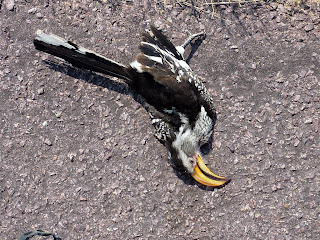The stories that I heard about safety in South Africa were full of warnings about robbery, or worse, and all of them had one clear message: don't ever camp wild in the bush. Well, I broke that good practice already on my first night in the country. The fence that is just 20 m from the road makes it hard to find a good camping place, so it took a while before I made a camp in a ditch right by the side of the road, invisible to the traffic - or at least that was what I hoped.
A village in the north of SA
Garderobe on display
On one occasion a young white man warned me about the "location", the black township, which I should avoid or cycle fast through. Terrified by all such robbery stories I had wrapped a couple of 100 Euro banknotes in plastic and had hidden them in my shoes. When I inspected them one of the following mornings, the banknotes had discolored as if they were forgotten in a washing machine. Jesus! Another one of my Mr. Bean episodes! Fortunately, I managed to change them in a bank in Zeerust. They're their problem now, and it serves them right, as they charged me outrageous 80 rands just for commission.
The "location"
In da tent
It was still considerably hot during the day in South Africa, above 30 °C, but the nights became much colder. At the sunrise after one particularly cold night that I spend wild camping in a tent, I got out to check what my thermometer showed. I was shocked to see it was -6 °C. In the tent it was probably warmer, but a layer of ice that accumulated inside tent walls, was a testimony that it was well below freezing. And I was in a summer sleeping bag! That morning, as I crowled out of the tent, I stumbled upon the tent guyline and broke the front tent pole. It was easy, though, to make a splint using the spare tent peg and a piece of duct tape, but now I was unable to fold the pole and store it in a tent pouch. However, I foud an excellent use of the repaired pole: I put it at the back so that it was sticking half a metre out into the road, preventing the cars to come too close.
Breakfast from Paul's magic kitchen at Pippa's in Bultfontain
A SA vista
And another one

Luckily, I didn't ride over one of these.
Taba Nchu residents.
Hard night's morning in Bluemfontain. Springboks lost against wallabies.

















































